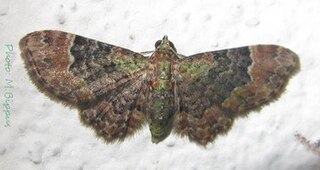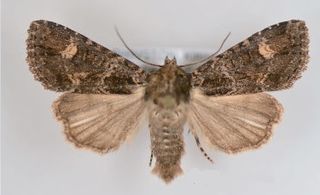
The v-pug is a moth of the family Geometridae. It is found throughout the Palearctic region, the Near East and North Africa. It is well distributed in the British Isles except for the north of Scotland. The species was first described by Adrian Hardy Haworth in 1809.

Banksia ser. Dryandra is a series of 94 species of shrub to small tree in the plant genus Banksia. It was considered a separate genus named Dryandra until early 2007, when it was merged into Banksia on the basis of extensive molecular and morphological evidence that Banksia was paraphyletic with respect to Dryandra.

The white-shouldered house moth is a species of gelechioid moth. It belongs to the subfamily Oecophorinae of the concealer moth family (Oecophoridae), just like the brown house moth. Though several presumed congeners of E. sarcitrella were described, its genus Endrosis is currently understood to be monotypic.
Cratochelone is an extinct genus of sea turtle in the family Protostegidae and containing a single species Cratochelone berneyi. The species is known only from the mid to late Albian Toolebuc Formation, part of the rolling downs group, in the Hughenden of Central northern Queensland, Australia.

Hyles livornica, the striped hawk-moth, is a moth of the family Sphingidae.

Pasiphilodes testulata, the pome looper, is a moth of the family Geometridae. The species was first described by Achille Guenée in 1857. It is found in Tasmania and on Norfolk Island, as well as in New Zealand and on the Chatham Islands and Kermadec Islands.

Chloroclystis filata, the filata moth, is a species of moth of the family Geometridae. It is found in New Zealand, the south eastern quarter of Australia and on Norfolk Island. Its host plants are acacias and Fabaceae.
Arthromastix is a genus of moths of the family Crambidae. It contains only one species, Arthromastix lauralis, which is found in Central America, South America, as well as the Dominican Republic and Cuba.

Chloroclystis is a genus of moths in the family Geometridae first described by Jacob Hübner in 1825.

Wintonotitan is a genus of titanosauriform dinosaur from late Albian -age Winton Formation of Australia. It is known from partial postcranial remains.

Aseptis binotata, the rusty shoulder knot moth, is a moth of the family Noctuidae. It is found widespread in western North America, west of south-central Alberta, Wyoming, and Nebraska. Along the Pacific Coast it occurs from northern Mexico to south-central British Columbia. It can be found from sea level to altitudes over 2000 meters in a variety of habitats from dense forest to shrub desert.

Chloroclystis inductata is a moth of the family Geometridae. It is endemic to New Zealand. It was first described by Francis Walker in 1862.

Chloroclystis approximata, the cherry looper moth, is a moth in the family Geometridae. It was described by Francis Walker in 1869. It is found in Australia.
Chloroclystis catastreptes is a moth in the family Geometridae. It was described by Meyrick in 1891. It is found in Australia.
Chloroclystis athaumasta is a moth in the family Geometridae. It was described by Turner in 1908. It is found in Australia (Queensland).
Chloroclystis pyrsodonta is a moth in the family Geometridae. It was described by Turner in 1922. It is found in Australia (Queensland). It has also been recorded from Fiji.
Scirpophaga nivella is a moth in the family Crambidae. It was described by Johan Christian Fabricius in 1794. It is found in southern Asia from the Indian Subcontinent in the west to southern China in the east, south to New Guinea and Australia, including New Caledonia and Fiji. Some sources have affixed the common name "sugarcane top borer" to it, despite it not being found in sugarcane, because they are confused with the species Scirpophaga excerptalis, which is an actual borer in the tops of sugarcane. Another newer common name that has been invented for these moths is "white rice borer".
Merlin Owen Pasco was a New Zealand entomologist. Pasco discovered several species of moth previously unknown to science and collected numerous specimens.
The Vietnam ferret-badger(Melogale cucphuongensis) is a member of the family Mustelidae native to Vietnam. It was described in 2011 and is known from only two specimens.

Hydriomena clarkei is a species of moth in the family Geometridae. This species is endemic to New Zealand. It is classified as "At Risk, Declining'" by the Department of Conservation.












